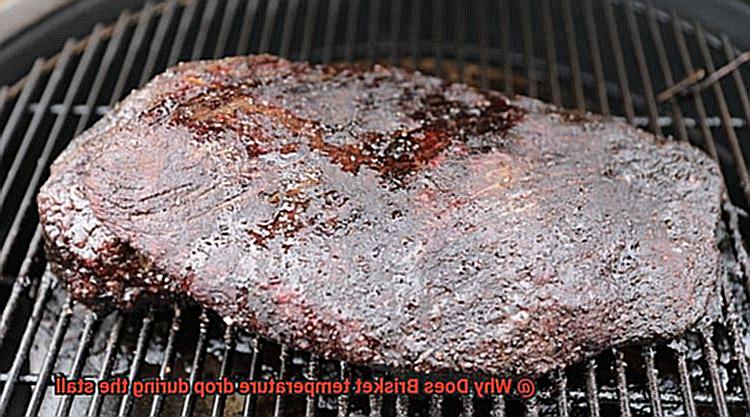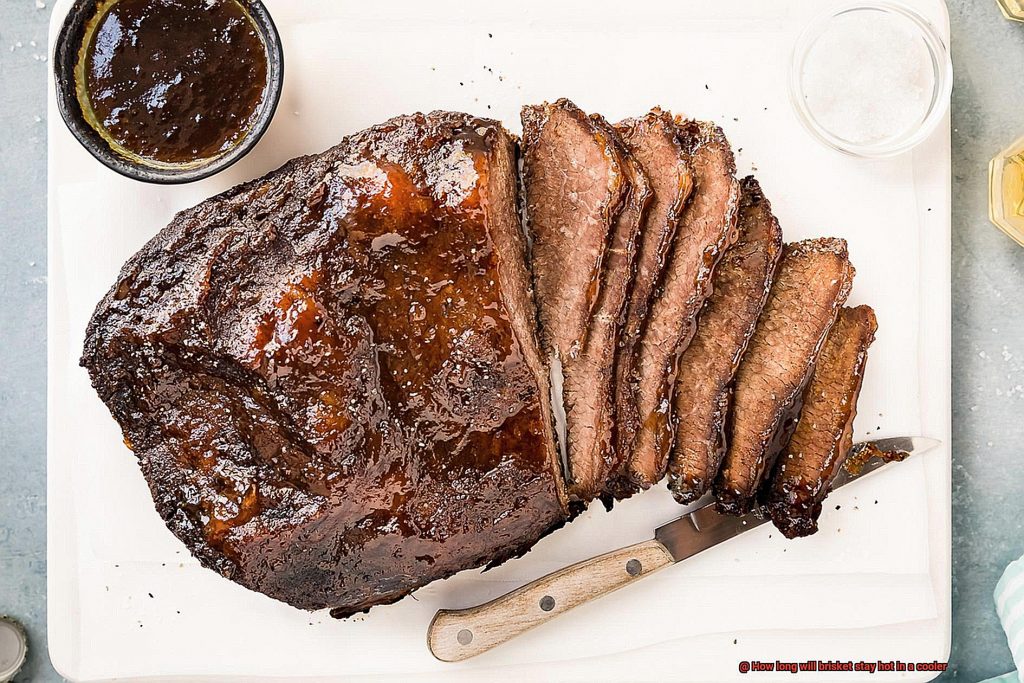If you’re a connoisseur of slow-cooked meats, you know that the stall is a real pain. It’s that frustrating period during the cooking process when the temperature of the meat seems to freeze, sometimes for hours on end. And when it comes to brisket, one of the toughest cuts of meat that requires low and slow cooking to achieve perfect tenderness, this can be especially noticeable. But even with careful preparation, the internal temperature of the brisket can suddenly drop, sending any experienced pitmaster into a frenzy.
The brisket stall is one of the most mysterious aspects of low-and-slow cooking. A well-cooked brisket will have a tender, smoky flavor and juicy texture, but the stall can make it uncertain if you’ll ever reach that state. So why does this sudden temperature drop happen? There are many theories out there, but one of the most popular explanations is that moisture leaving the brisket causes an evaporative cooling effect.
In this article, we’ll dive deeper and explore why brisket stalls occur and the science behind them. We’ll also discuss how you can overcome them to produce perfectly cooked brisket every time. Additionally, we’ll share some tips and tricks to help you get through the stall with minimal fuss and emerge with a mouth-watering, richly flavored brisket your guests will be begging for seconds of. So sit back, relax, and let’s unravel the mysteries behind this pesky obstacle in our quest for delicious barbecue perfection.
Contents
What is the Brisket Stall?
This frustrating period of time occurs when the temperature of the meat plateaus, or even drops, despite continued cooking. But don’t let this stall discourage you, because it’s actually an integral part of achieving a delicious and tender brisket.
The brisket stall typically occurs when the internal temperature of the meat reaches 150-160°F (65-71°C), causing moisture to evaporate and cool the surface of the brisket. Collagen and fat also begin to break down during this time, releasing additional moisture that can contribute to the stall. However, this breakdown process is essential for creating a tender and flavorful final product.
Rather than being an obstacle, many pitmasters embrace the brisket stall as an opportunity for flavor development. They prolong the stall by wrapping their brisket in foil or butcher paper to retain moisture and prolong the breakdown process. This results in a delicious finished product that will leave your taste buds singing.
So, next time you’re cooking a brisket and experience the stall, don’t panic. Instead, wait patiently and allow the meat to continue cooking until it reaches the desired internal temperature. Understanding why the brisket stall happens can help alleviate any concerns and result in a successful and mouth-watering cook.
Theory #1: Evaporative Cooling Effect of Moisture
The brisket stall – a moment of panic for many pitmasters. But fear not, for there is a fascinating theory behind this phenomenon: the evaporative cooling effect of moisture.
As the brisket cooks, it begins to release moisture through evaporation. This moisture cools the surface of the brisket, causing the internal temperature to plateau or even decrease. It’s like sweating on a hot summer day; as your sweat evaporates, it cools your skin down. The same principle applies to brisket – as moisture evaporates from the surface of the meat, it absorbs heat from the surrounding environment, causing the surface of the meat to cool and slowing down or halting the cooking process.
Several factors support this theory. Firstly, brisket contains a significant amount of moisture that evaporates and creates a humid environment inside your smoker or oven. Secondly, studies have shown that moisture can have a significant cooling effect on meat during cooking.
While some experts argue that evaporative cooling alone cannot account for the entirety of the brisket stall, understanding how moisture affects cooking temperature is key to producing perfectly cooked brisket every time.
But how can you prevent or mitigate the effects of this natural phenomenon? Wrapping your brisket in foil or butcher paper can help retain moisture and prevent too much evaporation. Increasing the cooking temperature slightly can also speed up the cooking process.
So embrace the stall and trust in the power of evaporative cooling to create a mouth-watering and tender finished product.
Theory #2: Collagen Breakdown
Understanding this theory will help you produce a tender and juicy brisket that will delight your taste buds.
Collagen is a protein found in connective tissues such as tendons, ligaments, and cartilage. In meat, collagen provides structure and support to muscle fibers. As the internal temperature of the brisket rises during cooking, collagen begins to break down, forming gelatin which contributes to the tenderness and juiciness of the meat.
However, at a certain temperature range (usually around 160-170°F), the breakdown process slows down or even stops altogether due to evaporative cooling. The moisture inside the meat evaporates, causing a cooling effect that creates a plateau or “stall” in the internal temperature of the meat. This stall can be frustrating for cooks as it can delay cooking time and affect the final texture of the meat.

But don’t worry, there are solutions to combat the stall. Wrapping the brisket in foil or butcher paper once it reaches this temperature range helps retain moisture and raises the internal temperature. This allows for continued collagen breakdown and faster cooking time.
Increasing the cooking temperature or adding more liquid to create a humid environment inside the smoker or oven can also help break down collagen faster and reduce stall time.
Embracing the Stall for Flavor Development
Fret not, my friends, because this stall is actually a crucial step in the development of the rich and smoky flavor that we all crave.
When the internal temperature of your brisket reaches 150-160°F, the moisture inside begins to evaporate, causing a cooling effect on the surface and leading to the stall. Instead of rushing through this stage by cranking up the heat, embrace it and let your brisket cook slowly and evenly. Trust me, it will be worth it in the end.
During this stall, the fat in your brisket slowly renders, infusing your meat with delicious flavor and tenderness. This is what gives brisket its signature smoky flavor and melt-in-your-mouth texture. So sit back, relax, and let your brisket work its magic.
To make the most of this flavor-building period, try adding wood chips or chunks to your smoker to create a rich smoke flavor. And don’t forget to baste your brisket with flavorful liquids like beer or apple cider vinegar.
By taking advantage of the stall and using these simple techniques, you’ll be rewarded with a mouthwatering brisket that will have your guests begging for seconds. So next time you hit that stall, don’t panic – just embrace it and let your brisket develop into a delicious masterpiece.
Overcoming the Stall
Today, let’s tackle a common obstacle that can hinder your brisket from reaching that perfect level of succulence – the stall. But don’t let this hurdle get you down. With some expert techniques and a little patience, you can overcome the stall and create a brisket that will have your taste buds rejoicing.
Wrapping your brisket in foil or butcher paper is an effective method to overcome the stall. By locking in moisture and heat, your brisket can keep cooking even when it hits that plateau. For an added boost of flavor, try the Texas Crutch method, where you wrap your brisket with liquid like apple juice or beer before placing it back on the grill or smoker. Just be cautious not to overcook or dry out your brisket when trying this method.
Another way to overcome the stall is by simply being patient. The stall happens due to evaporative cooling, where moisture on the surface of the meat evaporates and cools it down. As this process slows down, the temperature will start to rise again. It can take several hours, but resist the urge to increase the heat too much and wait it out.
If you’re feeling adventurous, you could try increasing the temperature of your grill or smoker when you hit the stall. This technique can help push through the plateau and get your brisket cooking again. But be careful; if you go too high, your brisket might dry out or overcook.
To sum up, overcoming the stall requires a combination of patience and technique. By using methods such as wrapping your brisket in foil or butcher paper, waiting out the stall, or increasing your grill temperature carefully, you’ll create a perfectly cooked brisket that’s full of mouth-watering flavor and tenderness.
bMd4ZXDvOho” >
Conclusion
In conclusion, the brisket stall is a necessary step in creating a delicious and tender brisket. When the internal temperature of the meat reaches 150-160°F, moisture evaporates and cools the surface of the brisket causing collagen and fat to break down. This breakdown process is crucial for creating a tender and flavorful final product.
There are several theories behind why the brisket stall happens, including the evaporative cooling effect of moisture and collagen breakdown. To overcome this obstacle, pitmasters can wrap their brisket in foil or butcher paper to retain moisture or increase cooking temperature slightly.
Rather than being an obstacle, many pitmasters embrace the brisket stall as an opportunity for flavor development. During this period, fat in your brisket slowly renders, infusing your meat with delicious flavor and tenderness. By adding wood chips or chunks to your smoker and basting your brisket with flavorful liquids like beer or apple cider vinegar, you can make the most of this flavor-building period.
In short, understanding the science behind the brisket stall is key to producing perfectly cooked brisket every time. With some patience and expert techniques under your belt, you’ll be able to overcome any stall and create a mouth-watering masterpiece that will have everyone begging for seconds.






